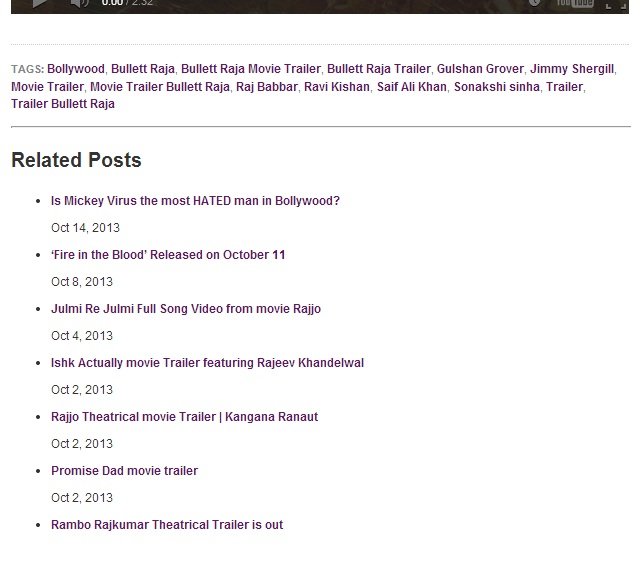Related Posts by Tags
WordPress has this amazing taxonomy known as “Post Tags” which you can use. You can tag each of your posts with multiple keywords. This algorithm would find other posts with any one of the tag that the current post has and will list them.
<?php $orig_post = $post;
global $post;
$tags = wp_get_post_tags($post->ID);
if ($tags) {
$tag_ids = array();
foreach($tags as $individual_tag) $tag_ids[] = $individual_tag->term_id;
$args=array(
‘tag__in’ => $tag_ids,
‘post__not_in’ => array($post->ID),
‘posts_per_page’=>5, // Number of related posts that will be shown.
‘caller_get_posts’=>1
);
$my_query = new wp_query( $args );
if( $my_query->have_posts() ) {echo ‘<div id=”relatedposts”><h3>Related Posts</h3><ul>’;
while( $my_query->have_posts() ) {
$my_query->the_post(); ?><li><div><a href=”<? the_permalink()?>” rel=”bookmark” title=”<?php the_title(); ?>”><?php the_post_thumbnail(); ?></a></div>
<div>
<h3><a href=”<? the_permalink()?>” rel=”bookmark” title=”<?php the_title(); ?>”><?php the_title(); ?></a></h3>
<?php the_time(‘M j, Y’) ?>
</div>
</li>
<? }
echo ‘</ul></div>’;
}
}
$post = $orig_post;
wp_reset_query(); ?>
The above code is looking at the current post ID and all tags which are associated with it and it uses the wp_query function to look for all other posts that matches any original tag and display them. You can style the post anyway you want them.
Advantage: Most codes on the web cannot be used within the main post loop. Because the related posts are placed right after the main post and above the comments, this code is very helpful. We are saving the current post ID of the main loop and then recalling it at the end of our related posts code. Usually when you don’t do it this way, the two post ID codes gets mixed up and then the comments start acting weird which can break the comments, other plugins related to comments such as numbering system etc. So this code is good and it works.
Usage: Place this code anywhere you like in your single.php and it will work. But most of the time it is placed right above the comments in the main loop.
Related Posts by Category
This algorithm would find other posts within the same category as the current post, and it will list them as related posts. The advantage of this technique is that you will never have a blank spot for your related posts section.
<?php $orig_post = $post;
global $post;
$categories = get_the_category($post->ID);
if ($categories) {
$category_ids = array();
foreach($categories as $individual_category) $category_ids[] = $individual_category->term_id;$args=array(
‘category__in’ => $category_ids,
‘post__not_in’ => array($post->ID),
‘posts_per_page’=> 2, // Number of related posts that will be shown.
‘caller_get_posts’=>1
);$my_query = new wp_query( $args );
if( $my_query->have_posts() ) {
echo ‘<div id=”related_posts”><h3>Related Posts</h3><ul>’;
while( $my_query->have_posts() ) {
$my_query->the_post();?><li><div><a href=”<? the_permalink()?>” rel=”bookmark” title=”<?php the_title(); ?>”><?php the_post_thumbnail(); ?></a></div>
<div>
<h3><a href=”<? the_permalink()?>” rel=”bookmark” title=”<?php the_title(); ?>”><?php the_title(); ?></a></h3>
<?php the_time(‘M j, Y’) ?>
</div>
</li>
<?
}
echo ‘</ul></div>’;
}
}
$post = $orig_post;
wp_reset_query(); ?>
This technique utilizes the same functions as the one above except we are just using the different criteria.
If you are creating a new project, or working on a client’s site, this could be very helpful.
